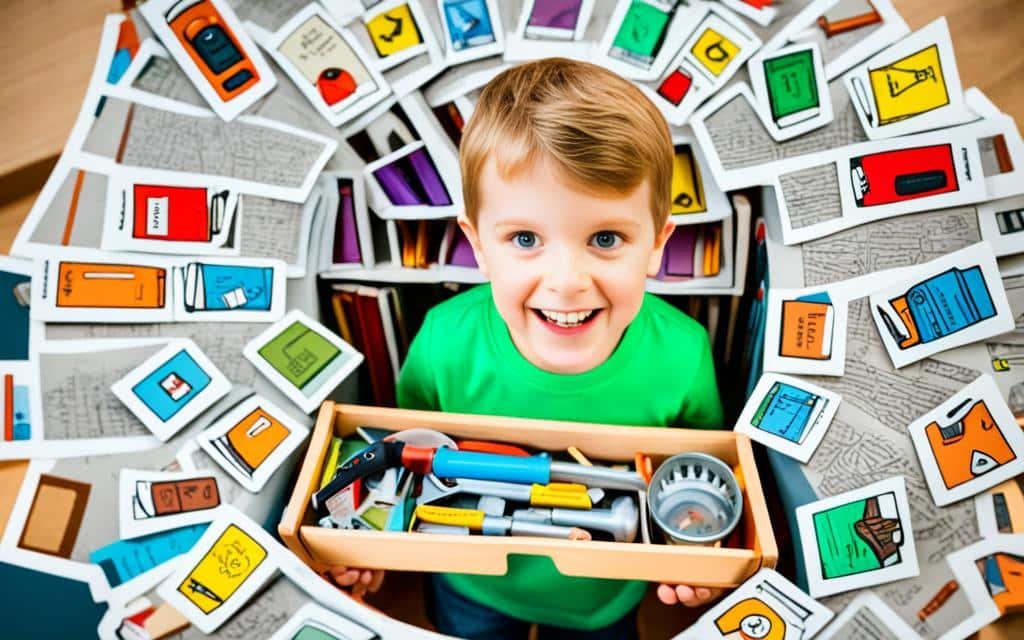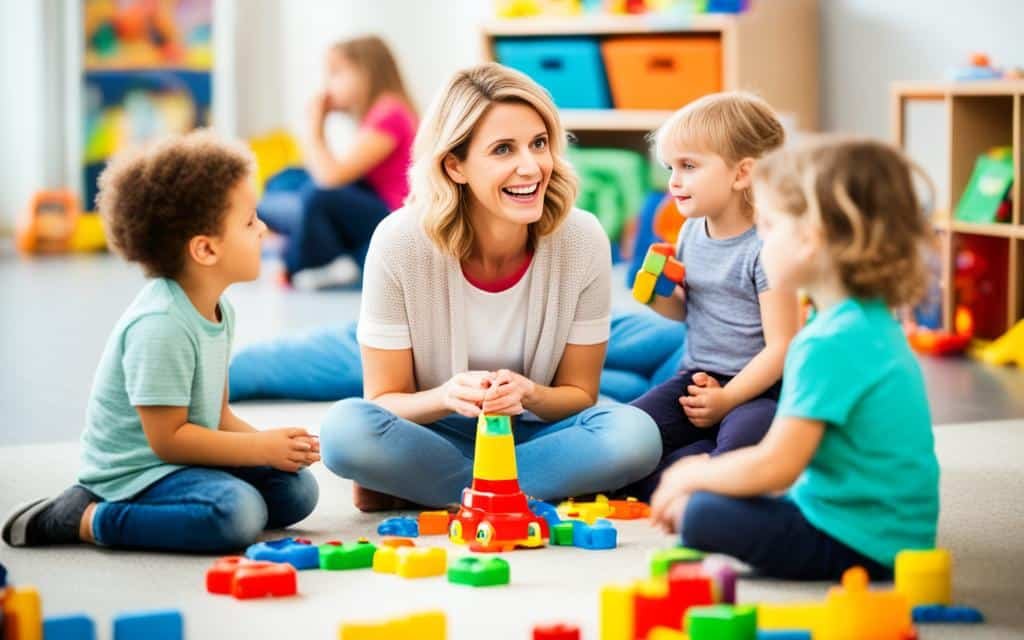Dear Parent,
As a parent, you want nothing more than to see your child happy, confident, and carefree. But what if it is struggling with child anxiety? What if you see their little face filled with worry, their hands trembling nervously, their nights disrupted by nightmares?
I know firsthand how heart-wrenching it can be to watch your child battle anxiety. My own daughter, Emma, used to experience intense anxiety before school every morning. It broke my heart to see her struggle, and I felt helpless, unsure of how to ease her worries and fears.
But through research, trial and error, and the unwavering love and support of Emma’s mother and me, we learned how to navigate the challenging journey of managing child anxiety. And now, I want to share with you the practical tips and strategies that have made a significant difference in our daughter’s life.
Together, we’ll explore the causes and signs of child anxiety, demystify anxiety in children, and understand your pivotal role as a parent in managing your child’s anxiety. I’ll provide you with practical strategies to aid your child’s anxiety, teach you how to apply anxiety management techniques in everyday activities, and guide you in creating open conversations about anxiety.
So, take a deep breath, dear parent, because you are not alone on this journey. Together, we can empower our children to conquer their anxiety and thrive.
Recognizing Child Anxiety in Today’s World
In today’s world, child anxiety is becoming more prevalent. It is crucial for parents to be able to recognize the signs of anxiety in their children. This section will discuss the common signs and symptoms of child anxiety and provide guidance on how to identify anxiety in children.
Child anxiety can manifest in various ways, and every child may display different symptoms. However, there are some common signs that parents can look out for. These signs may include:
- Excessive worrying: Children with anxiety often worry excessively about multiple things, even everyday situations or events.
- Frequent physical complaints: Headaches, stomachaches, and other physical complaints that have no known medical cause can be a sign of underlying anxiety.
- Sleep disturbances: Anxiety can disrupt a child’s sleep patterns, leading to difficulty falling asleep, frequent nightmares, or night terrors.
- Social withdrawal: Anxious children may avoid social situations, exhibit shyness, or have difficulty making friends.
- Changes in behavior: Anxiety can cause changes in a child’s behavior, such as being irritable, having difficulty concentrating, or becoming more clingy.
- Perfectionism: Children with anxiety often display perfectionistic tendencies and may be excessively hard on themselves.
It is important to note that these signs and symptoms may vary depending on the child’s age, personality, and individual circumstances. Additionally, anxiety in children can sometimes be mistaken for other conditions, such as ADHD or learning disabilities. Therefore, it is essential for parents to consult with a healthcare professional for a proper diagnosis.
“Recognizing the signs of child anxiety is the first step in providing the necessary support and intervention. By accurately identifying anxiety in children, parents can take proactive measures to help their child manage their anxiety effectively.”
Demystifying Anxiety in Children
Anxiety in children can often be misunderstood and overlooked. As a parent, it is important to gain a better understanding of anxiety in children to provide the necessary support. By demystifying anxiety, you can shed light on the causes, risk factors, and common anxiety disorders that affect kids.
Anxiety in children can be triggered by various factors such as genetics, brain chemistry, personality traits, or life experiences. It is important to note that anxiety disorders are not the result of poor parenting or anything the child has done wrong. They are legitimate medical conditions that require understanding and treatment.
Common anxiety disorders in children include:
- Generalized Anxiety Disorder (GAD): Persistent and excessive worry about various aspects of life, such as school performance, friendships, or personal safety.
- Social Anxiety Disorder: Intense fear of social situations and an excessive worry about being embarrassed, judged, or humiliated.
- Separation Anxiety Disorder: Extreme fear or worry about being away from their parents or caregivers.
- Panic Disorder: Recurrent panic attacks characterized by sudden and overwhelming fear, often accompanied by physical symptoms such as a racing heart or shortness of breath.
- Specific Phobias: Intense fear and avoidance of specific objects or situations, such as animals, heights, or flying.
By understanding these anxiety disorders, parents can recognize the unique challenges their child may face and seek appropriate help and treatment. It is essential to consult with a healthcare professional, such as a pediatrician or child psychologist, for a proper diagnosis and guidance on managing anxiety in children.

The Role of Parents in Managing Childhood Anxiety
Parents play a crucial role in managing childhood anxiety. By understanding and actively addressing their child’s anxiety, parents can create a supportive environment that fosters emotional well-being. This section will explore the various ways parents can contribute to managing their child’s anxiety effectively.
Understanding the Balance Between Support and Overprotection
It is natural for parents to want to protect their child from distressing situations. However, it is important to strike a balance between support and overprotection. On one hand, providing a safe and supportive environment is essential for a child’s emotional well-being. On the other hand, overly protecting children can hinder their ability to develop resilience and coping mechanisms. Encouraging children to face their fears in a controlled manner can help them build confidence and manage their anxiety in the long run.
The Power of Validating a Child’s Feelings
Validating a child’s feelings is a powerful tool in managing their anxiety. When children feel heard and understood, it helps them develop a sense of trust and connection with their parents. By validating their emotions, parents can create a safe space for their child to express their anxiety without judgment or dismissal. This empathetic approach enables children to develop emotional resilience and empowers them to manage their anxiety more effectively.
Communicating Confidence Rather Than Assurance
While it’s important for parents to provide reassurance to their anxious child, it is equally crucial to communicate confidence in their child’s ability to cope with anxiety. Instead of repeatedly assuring children that nothing bad will happen, parents can focus on instilling confidence by acknowledging their child’s strengths and highlighting their past successes in managing anxiety. This approach helps children develop self-belief and a sense of control over their anxiety, ultimately leading to greater independence in anxiety management.
Practical Strategies to Aid Your Child’s Anxiety
When it comes to helping your child manage their anxiety, practical strategies can make a significant difference in their well-being. By implementing these techniques, you can provide the support and guidance they need to navigate their anxiety with confidence. This section will explore three key strategies: teaching mindfulness and coping techniques, cultivating problem-solving skills and autonomy, and monitoring your reactions to model calmness for your child.
Teaching Mindfulness and Coping Techniques
An effective way to help your child cope with anxiety is by teaching them mindfulness techniques. Mindfulness involves focusing on the present moment and accepting their thoughts and feelings without judgment. This practice can help them become more aware of their anxiety triggers and develop healthier coping mechanisms.
“Mindfulness is the key to unlocking your child’s ability to manage anxiety. By helping them stay present and teaching them simple techniques like deep breathing or grounding exercises, you can empower them to regain control when anxiety strikes.” – Dr. Sarah Wilson, Child Psychologist
In addition to mindfulness, you can also teach your child various coping techniques such as progressive muscle relaxation or journaling. Encourage them to find activities that help them relax and express their emotions, such as drawing, listening to music, or engaging in physical exercise.
Cultivating Problem-Solving Skills and Autonomy
Building your child’s problem-solving skills and autonomy can contribute to their ability to manage anxiety effectively. Encourage them to identify their fears and brainstorm potential solutions. Guiding them through this process helps them develop a sense of control and confidence in their ability to overcome challenges.
As their independence grows, allow them to make decisions within appropriate boundaries. This fosters a sense of responsibility and self-reliance. It’s important to strike a balance between offering guidance and allowing them to navigate their anxieties independently, ensuring they feel supported while also developing their own coping mechanisms.
Monitoring Your Reactions and Modeling Calmness
As a parent, your reactions play a significant role in shaping your child’s response to anxiety. It’s crucial to be mindful of your own emotions and responses, as children often mirror their parents’ behavior. Demonstrating calmness and resilience in the face of stress can reassure your child and provide them with a positive example to follow.
When your child expresses anxiety, offer comfort and validation. Remind them that it’s natural to feel anxious and that you are there to support them. Avoid dismissing or minimizing their fears, as this can invalidate their emotions. Instead, listen attentively and provide reassurance while also encouraging them to face their fears gradually.
Remember, coping with your child’s anxiety requires patience and a supportive approach. By utilizing practical strategies like teaching mindfulness, fostering problem-solving skills, and modeling calmness, you can empower your child to navigate their anxiety and build resilience for the long term.

Application of Anxiety Management in Daily Activities
Anxiety management techniques are valuable tools for helping your child navigate their daily activities with ease and confidence. By incorporating these strategies into various aspects of their routine, you can provide them with the support they need to effectively manage their anxiety. Here are some practical examples and suggestions for applying anxiety management techniques in your child’s daily activities:
- Incorporate deep breathing exercises into the morning routine to help your child start the day feeling calm and centered.
- Encourage your child to practice mindfulness during mealtimes to promote relaxation and enjoyment of their food.
- When it comes to school, collaborate with your child’s teachers to establish a safe and supportive learning environment. This can include creating a quiet space for breaks, setting realistic goals, and providing positive reinforcement.
- Help your child develop effective time management skills to minimize stress and anxiety related to deadlines and tasks.
- Support your child in building strong social connections by facilitating playdates, encouraging participation in group activities, and teaching them social skills to navigate social interactions confidently.
- Encourage your child to engage in regular physical exercise, as it can help reduce anxiety and improve overall well-being.
- Explore relaxation techniques such as guided imagery, progressive muscle relaxation, or yoga as part of your child’s daily routine.
Remember, consistency is key when applying anxiety management techniques in your child’s daily activities. By incorporating these strategies into various aspects of their routine, you can help your child develop resilience and cope with anxiety effectively.
Encouraging Open Conversations About Anxiety
Open conversations about anxiety can help children feel understood and supported. It is important for parents to create a safe space where their children can express their feelings and thoughts about their anxiety. This section will explore effective strategies to encourage open conversations about anxiety with kids.
Asking Open-Ended Questions
One way to facilitate open conversations about anxiety is by asking open-ended questions. Instead of asking yes or no questions, encourage your child to share their thoughts and emotions by asking questions like:
- “How did that situation make you feel?”
- “What thoughts were going through your mind when you felt anxious?”
- “Tell me more about what worries you.”
These open-ended questions give your child the opportunity to express themselves more freely and provide deeper insights into their anxieties.
Avoiding Assumptions and Leading Queries
When discussing anxiety with your child, it is important to avoid making assumptions or leading queries. Instead of imposing your own thoughts or feelings, try to create a non-judgmental environment where your child feels comfortable sharing their experiences. Listen attentively and let them guide the conversation.
“I’ve noticed that you’ve been feeling anxious lately. Can you tell me more about what’s been going on?”
This open approach encourages your child to open up and express their feelings without feeling pressured or judged. It allows for a deeper understanding of their anxiety and helps build trust and connection.
Redefining the Narrative Around Anxiety
Another important aspect of encouraging open conversations about anxiety is to redefine the narrative around it. Anxiety is a normal human experience, and it is essential to convey this to your child. Help them understand that anxiety is not something to be ashamed of or something they need to hide.
Reframe anxiety as a natural response to certain situations and explain that it is something that can be managed with the right support and coping strategies. By promoting a positive and empowering view of anxiety, you can help your child develop a healthier mindset and open dialogue about their anxious feelings.

Child Anxiety: Adopting a Long-Term Perspective for Well-Being
When it comes to managing your child’s anxiety, it’s essential to adopt a long-term perspective. Anxiety can be a complex and lifelong journey, and providing ongoing support is crucial for your child’s well-being, even as they grow older.
Understanding that anxiety may not disappear overnight is the first step. Instead of searching for quick fixes, focus on creating a supportive environment that nurtures your child’s emotional development. Remember, your ultimate goal is to equip your child with the tools and resilience necessary to navigate their anxiety in the long run.
Stay attuned to your child’s emotions and provide a safe space for them to express themselves. Encourage open conversations about their anxiety and validate their feelings. By doing so, you create an atmosphere of trust and understanding, which can make a significant difference in your child’s well-being.
Additionally, consider seeking professional help if needed. A mental health professional can provide guidance and strategies tailored to your child’s specific needs. Regular therapy sessions can equip both you and your child with valuable coping techniques and ensure you’re on the right track towards long-term management of anxiety.
Remember that managing child anxiety is a continuous process, and it’s normal for your child to experience ups and downs. Be patient, understanding, and celebrate their progress, no matter how small. With your support and a long-term perspective, you can empower your anxious child to lead a fulfilling and meaningful life.
Strategies for Long-Term Management of Child Anxiety
| Strategy | Description |
|---|---|
| Develop a support network | Connect with other parents and professionals who can offer advice, understanding, and support. |
| Promote self-care | Encourage your child to prioritize self-care activities that promote relaxation, such as exercise, hobbies, and mindfulness. |
| Implement gradual exposure | Gradually expose your child to anxiety-triggering situations in a controlled and supportive manner to build resilience. |
| Teach problem-solving skills | Help your child develop problem-solving skills to empower them in managing their anxiety-inducing situations. |
| Encourage healthy coping mechanisms | Support your child in finding healthy coping mechanisms, such as deep breathing exercises or journaling, to manage their anxiety. |
Conclusion
Child anxiety is a real and challenging issue that many parents face today. Throughout this article, we have explored various aspects of child anxiety and provided practical tips for parents. It is important to remember that understanding, supporting, and empowering anxious children is crucial for their well-being.
By recognizing the signs of anxiety in children and demystifying anxiety, parents can gain a better understanding of what their child is experiencing. It is vital to strike a balance between support and overprotection, allowing children to face their fears while providing a safe and supportive environment.
Practical strategies such as teaching mindfulness and coping techniques, cultivating problem-solving skills, and modeling calmness can greatly benefit children with anxiety. By incorporating anxiety management techniques into daily activities, parents can help their child develop effective coping mechanisms.
Encouraging open conversations about anxiety is essential for children to feel understood and supported. By asking open-ended questions, avoiding assumptions, and redefining the narrative around anxiety, parents can create a safe space for their child to express their feelings and thoughts.
In conclusion, dealing with child anxiety requires a long-term perspective and ongoing support. By understanding their child’s anxiety, supporting them through their journey, and empowering them to manage their anxiety effectively, parents can make a difference in their child’s overall well-being. Remember that you are not alone on this journey, and there are resources available to help you navigate through the challenges of managing child anxiety.
FAQ
What are the signs of child anxiety?
Common signs of child anxiety can include excessive worrying, avoiding certain situations or activities, physical symptoms such as headaches or stomachaches, difficulty sleeping, irritability, restlessness, and difficulty concentrating.
How can I recognize anxiety in my child?
Pay attention to any changes in your child’s behavior, such as increased clinginess, mood swings, or withdrawal from social activities. If you notice persistent signs of anxiety that interfere with your child’s daily life or development, it may be important to consult with a healthcare professional.
What are the common anxiety disorders that affect children?
Common anxiety disorders in children include generalized anxiety disorder (GAD), separation anxiety disorder, social anxiety disorder, specific phobias, and panic disorder. Each of these disorders has its own specific symptoms and characteristics.
How can parents manage their child’s anxiety?
Parents can manage their child’s anxiety by finding a balance between support and overprotection. It’s important to validate a child’s feelings, communicate confidence instead of assurance, and create a safe and supportive environment for them to face their fears. Seeking professional help and incorporating coping strategies can also be beneficial.
What are some practical strategies to help my child with anxiety?
Teaching mindfulness and coping techniques can help your child manage their anxiety. Cultivating problem-solving skills and promoting autonomy can also empower them. Additionally, monitoring your own reactions and modeling calmness can have a positive impact on your child’s anxiety management.
How can I apply anxiety management techniques in my child’s daily activities?
You can incorporate anxiety management techniques into your child’s daily activities by providing them with opportunities to practice their coping skills. For example, you can create a routine that includes relaxation exercises before bedtime or encourage them to use their coping strategies when facing challenging situations at school or during social interactions.
How can I encourage open conversations about anxiety with my child?
Asking open-ended questions can help your child feel more comfortable expressing their feelings and thoughts about anxiety. Avoid making assumptions or leading queries that might pressure your child into a specific response. Redefine the narrative around anxiety to create a safe space for open and honest conversations.
Should I take a long-term perspective when managing my child’s anxiety?
Yes, it is important to take a long-term perspective when managing your child’s anxiety. Focus on their overall well-being and provide ongoing support throughout their development. Remember that anxiety management is a journey, and nurturing your child’s mental health requires consistent attention and understanding.










